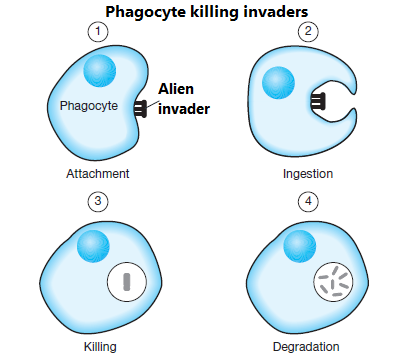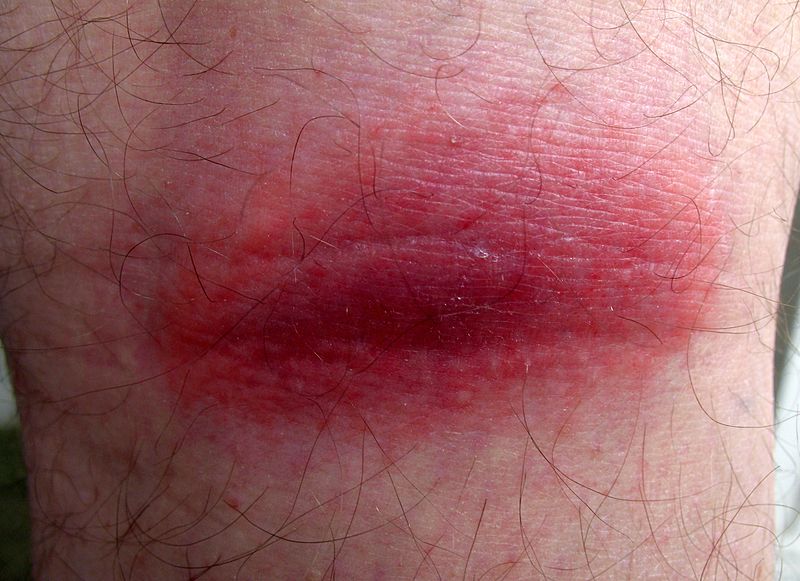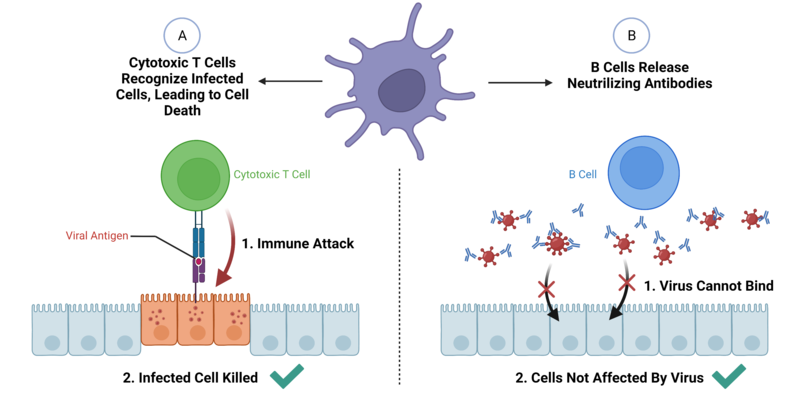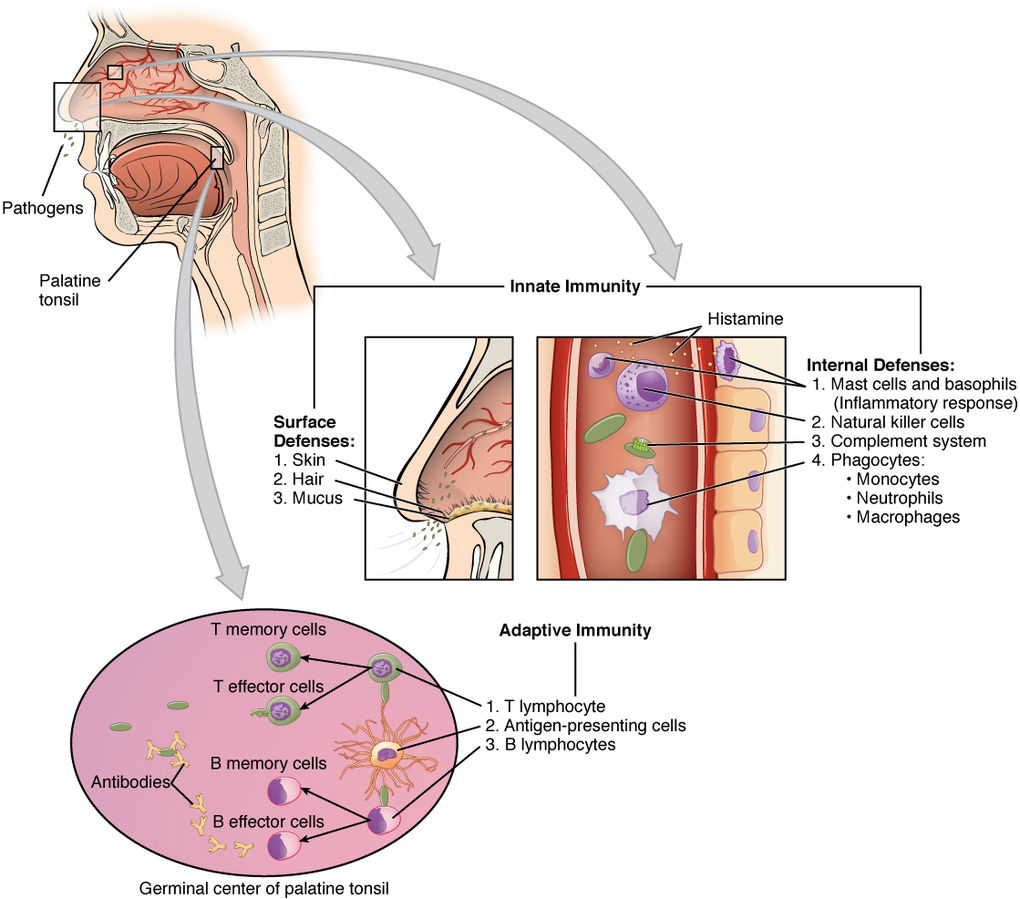11.5 Physiology of the Lymphatic and Immune Systems
Immune Response
There are two basic processes in which the human body defends against microorganisms that cause infection, referred to as a nonspecific, innate immune response and a specific, adaptive immune response.
Innate Immune Response
The nonspecific, innate immune response (ĭn-NĀT i-MŪN ri-SPONS) refers to defenses that target invading pathogens in a nonspecific manner. It is called “innate” because it is present from the moment we are born. Pathogens (PĂTH-ō-jĕnz) refer to bacteria, viruses, or other microorganisms that can cause infection and disease. The innate immune response includes physical barriers, inflammation, and fever.[1]
Physical Barriers
Physical barriers are the body’s basic defenses against infection. These physical barriers are also referred to as the body’s first line of defense. They include intact skin and mucous membranes, as well as mucus and enzymes, that physically destroy and/or remove pathogens and debris from areas of the body where they might cause harm or infection. Other examples of physical barriers include tears, acidity in the urine and reproductive tracts, and sebum (the protective oil secreted through hair follicles onto the skin).[2]
Internal Defenses
Internal defenses are also referred to as the body’s second line of defense. These work to protect the body if a pathogen gets past the physical barriers and into the body. Examples of internal defenses include phagocytosis, inflammatory response, and fever.[3]
Phagocytosis
Phagocytosis (făg-ō-sī-TŌ-sĭs) refers to the process of cells engulfing and destroying pathogens (i.e., “cells eating”). Monocytes are a type of white blood cell that are macrophages (big eaters). Macrophages “eat up” damaged cells, pathogens, and debris. Another type of white blood cell called neutrophils are also called phagocytes, but as they “clean up,” they become toxic and die, creating pus. Neutrophils are typically the first cells on site to a new infection.[4] See Figure 11.4[5] for an image of phagocytosis.

Inflammatory Response
Inflammation (in-flă-MĀ-shŏn) is characterized by heat, redness, pain, and swelling. Although inflammation is often perceived as a negative consequence of injury or disease, it is an important process that recruits immune defenses to eliminate pathogens, remove damaged and dead cells, and initiate repair mechanisms.[6]
During the inflammatory response (ĭn-FLĂM-ă-tŏr-ē ri-SPONS), the damaged cells release chemicals, including histamine (HIS-tă-mēn). These chemicals cause redness, heat, and increased permeability of blood vessels so fluid leaks into tissues, causing swelling. These chemicals also attract phagocytes and lymphocytes.[7] See Figure 11.5[8] for an image of inflammation.

Fever
Fever (FĒ-vŏr), also referred to as pyrexia, is part of the inflammatory response that extends beyond the site of infection and affects the entire body, resulting in an overall increase in body temperature. Health care providers generally consider a fever to be 100.4°F (38°C) or higher. Fever enhances the innate immune response by stimulating white blood cells to kill pathogens. The rise in body temperature also inhibits the growth of many pathogens.[9]
View the following supplementary YouTube video[10] on nonspecific innate immunity: Immune System, Part 1: Crash Course Anatomy & Physiology #45
Adaptive Immune Response
The adaptive immune response (ă-dăp-tĭv ĭ-mūn rĭ-spŏns) is activated when the nonspecific, innate immune response is insufficient to control an infection. The adaptive immune response requires the body’s exposure to a pathogen to recognize it as a threat in order for it to respond. Exposure can be through direct contact or via immunization. After the adaptive immune system has been exposed to a pathogen, it develops memory cells to recognize this pathogen in the future and quickly mount a defense.[11]
A lymphocyte (LIM-fō-sīt), a specific type of white blood cell, plays a key role in the adaptive immune response. There are two main groups of lymphocytes called B cells and T cells, both of which are formed in bone marrow (bōn MAR-ō). B cells mature in the bone marrow, and T cells mature in the thymus, the rationale for being called “B” cells and “T” cells. B cells are involved in humoral immunity (i.e., immune functions in the blood and other fluids in the body), and T cells are involved in cell-mediated defenses (i.e., fighting invaders within cells).[12]
Humoral Immunity: B cells
Humoral immunity (HYŌŌ-mŏr-ăl ĭ-mū-nĭ-tē) refers to the function of B cells and their production of antibodies. B cells originate and develop in the bone marrow and then migrate in body fluids through the lymph nodes, spleen, and blood to seek out and destroy pathogens in the interstitial spaces. B cells make plasma cells that produce Y-shaped proteins called antibodies (ANT-i-bod-ēz) that destroy pathogens based on their antigens. Antigens (ĂN-tĭ-jĕnz) are markers that tell the immune system whether something in the body is harmful or not. Antigens are found on viruses, bacteria, cancer cells, and even normal cells of the body. Each antigen has a unique shape that the immune system reads like a nametag to know whether or not it belongs in that person’s body. Antibodies are very specific to the antigens they recognize and destroy. They fit onto the antigen like a key to a lock.[13]
When a B cell finds an abnormal cell with an antigen that it has antibodies for, it binds to it and responds by cloning itself into many B cells and differentiating into plasma cells, which release thousands of antibodies per second to attack the pathogen. Some B cells become memory B cells that are involved in immunological memory to ensure a stronger and faster antibody response if the body is exposed to the same antigen in the future.
View the following supplementary YouTube video[14] on adaptive immunity: Immune System, Part 2: Crash Course Anatomy & Physiology #46
Passive Immunity
Passive immunity (PĂS-ĭv im-Ū-nĭt-ē) is a type of immunity obtained by receiving antibodies produced by someone else. For example, infants have passive immunity because they are born with antibodies they received through the placenta from their mother. However, these antibodies are unable to create effector cells or memory cells, so it won’t remember an antigen if it gets infected again. These antibodies disappear between 6 and 12 months of age. Breast milk also contains antibodies, so babies who are breastfed have passive immunity for a longer period of time.[15]
Passive immunization can also be transferred via an injection of antibodies formed by another person or animal. There are five classes of antibodies comprised of the following immunoglobulins: IgG, IgM, IgA, IgD, and IgE. Immunoglobulins provide immediate protection against an antigen, but do not provide long-lasting protection. For example, Hepatitis B Immune Globulin (HBIG) is administered to individuals who have been exposed to hepatitis B as passive immunization to help fight the infection.[16]
Cell-Mediated Response: T cells
When nonspecific, innate immunity and humoral immunity are not effective in defending against pathogens or abnormal cells, the body responds with a cell-mediated response (Sĕl-mēd-ē-āt-ed rĭ-spŏns) using lymphocyte T cells to destroy the abnormal cells. There are two major types of T cells called helper T cells and killer T cells[17]:
- Helper T cells use chemical messengers to activate the adaptive immune response. They stimulate B cells to make antibodies and help develop the killer T cells.
- Killer T cells, also called natural killer (NK) cells or cytotoxic cells, directly kill cells that have been invaded by a virus or are otherwise abnormal. They also clone themselves into many effector T cells and create memory T cells for immunological memory of the antigen.
See Figure 11.6[18] for a comparison of the function of B cells and cytotoxic T cells. The purple cell is an invading virus. The B cells release antibodies to fight the virus and protect the body’s cells from being invaded by the virus. The cytotoxic T cells recognize body cells that have been infected by the virus and destroy them.

Chemical messaging occurs during the immune response and includes cytokines. Cytokines (SĪ-tō-kīnz) are proteins secreted by cells that act as chemical messengers in immune responses. When a pathogen enters the body, the first immune cell to notice the pathogen is like the conductor of an orchestra. That cell directs all the other immune cells by creating and sending out messages (cytokines) to the rest of the organs or cells in the body to respond to and initiate inflammation.[19]
See Figure 11.7[20] for an illustration of innate immunity and specific adaptive immunity using an example of a pathogen entering the body through the nose.

View the following YouTube video[21] on cell-mediated immune response: Immune System, Part 3: Crash Course Anatomy & Physiology #47
Immunological Memory
Immunological memory (im-yŭ-NOL-ŏ-jē- kăl MEM-ŏ-rē) refers to the ability of the adaptive immune response to mount a stronger and faster immune response upon reexposure to a pathogen. Memory B and T cells for each specific pathogen are created that provide long-term protection from reinfection with that pathogen. On reexposure, these memory cells facilitate an efficient and quick immune response. For example, when an individual recovers from chicken pox, the body develops a memory of the varicella-zoster virus that will specifically protect it from reinfection if exposed to the virus again.[22]
Acquired immunity refers to immunity that develops with exposure to various antigens as an individual’s immune system builds a defense. However, pathogens can mutate and change the shape of their antigens so the immune system can no longer recognize or defend against it.[23] For example, influenza viruses mutate frequently, requiring annual influenza vaccination.
Immunization
Immunization (ĭm-yū-nĭ-zā-shŏn) is a method to trigger an individual’s acquired immune response and prevent future disease. A vaccine is an agent administered by injection, orally, or by nasal spray that provides active acquired immunity to a particular infectious disease. Small doses of a viral antigen are given to activate immunological memory. Memory cells allow the body to react quickly if exposed to the recognized antigen and efficiently defend against the virus.[24]
Stress and the Immune System
Hormones released during the stress response (also known as the “fight or flight” response by the sympathetic nervous system) include epinephrine, cortisol, and corticosteroids. These hormones suppress T cell immune response, which can result in a weakened immune system. Additionally, long-term stress is associated with an increase in stress-related diseases like hypertension and coronary artery disease.[25]
The Immune Response and Cancer
There are three stages of the immune response to many malignancies[26]:
- Elimination (ĭ-lĭm-ĭ-nā-shŏn) occurs when the immune response first develops antibodies toward tumor-specific antigens and actively kills most cancer cells.
- Equilibrium (ē-kwĭ-lĭb-rē-ŭm) is the period that follows elimination when remaining cancer cells are held in check.
- Escape (ĕs-kāp) from the immune response occurs because many cancers mutate and no longer express specific antigens for which the immune system responds.
- This work is a derivative of Health Alterations by Open RN and is licensed under CC BY 4.0 ↵
- This work is a derivative of Anatomy and Physiology by OpenStax licensed under CC BY 4.0. Access for free at https://openstax.org/books/anatomy-and-physiology/pages/1-introduction ↵
- This work is a derivative of Anatomy and Physiology by OpenStax licensed under CC BY 4.0. Access for free at https://openstax.org/books/anatomy-and-physiology/pages/1-introduction ↵
- A.D.A.M. Medical Encyclopedia [Internet]. Atlanta (GA): A.D.A.M., Inc.; c1997-2023. Immune response; [reviewed 2022, Jan 23; cited 2023, Nov 7). https://medlineplus.gov/ency/article/000821.htm ↵
- “phagocytes.png” by zzzi zeth is licensed in the Public Domain. ↵
- This work is a derivative of Anatomy and Physiology by OpenStax licensed under CC BY 4.0. Access for free at https://openstax.org/books/anatomy-and-physiology/pages/1-introduction ↵
- This work is a derivative of Anatomy and Physiology by OpenStax licensed under CC BY 4.0. Access for free at https://openstax.org/books/anatomy-and-physiology/pages/1-introduction ↵
- “Tickbite_Inflammation_2482a.jpg” by Túrelio is licensed under CC BY-SA 3.0-de ↵
- This work is a derivative of Anatomy and Physiology by OpenStax licensed under CC BY 4.0. Access for free at https://openstax.org/books/anatomy-and-physiology/pages/1-introduction ↵
- CrashCourse. (2015, December 8). Immune system, Part 1: Crash Course Anatomy & Physiology #45 [Video]. YouTube. All rights reserved. https://youtu.be/GIJK3dwCWCw?si=YFX4Rpb4U8a_dyPS ↵
- This work is a derivative of Health Alterations by Open RN and is licensed under CC BY 4.0 ↵
- This work is a derivative of Anatomy and Physiology by OpenStax licensed under CC BY 4.0. Access for free at https://openstax.org/books/anatomy-and-physiology/pages/1-introduction ↵
- Cleveland Clinic. (2022, August 16). Antigen. https://my.clevelandclinic.org/health/diseases/24067-antigen ↵
- CrashCourse. (2015, December 8). Immune system, Part 2: Crash Course Anatomy & Physiology #46 [Video]. YouTube. All rights reserved. https://youtu.be/2DFN4IBZ3rI?feature=shared ↵
- A.D.A.M. Medical Encyclopedia [Internet]. Atlanta (GA): A.D.A.M., Inc.; c1997-2023. Immune response; [reviewed 2022, Jan 23; cited 2023, Nov 7). https://medlineplus.gov/ency/article/000821.htm ↵
- A.D.A.M. Medical Encyclopedia [Internet]. Atlanta (GA): A.D.A.M., Inc.; c1997-2023. Immune response. https://medlineplus.gov/ency/article/000821.htm ↵
- This work is a derivative of Anatomy and Physiology by OpenStax licensed under CC BY 4.0. Access for free at https://openstax.org/books/anatomy-and-physiology/pages/1-introduction ↵
- “General_Effector_Mechanisms_of_B_and_T_Cells.png” by סתו כסלו is licensed under CC BY-SA 4.0 ↵
- This work is a derivative of Anatomy and Physiology by OpenStax licensed under CC BY 4.0. Access for free at https://openstax.org/books/anatomy-and-physiology/pages/1-introduction ↵
- “2211_Cooperation_Between_Innate_and_Immune_Responses.jpg” by OpenStax is licensed under CC BY 3.0 ↵
- CrashCourse. (2015, December 21). Immune system, Part 3: Crash Course Anatomy & Physiology #47 [Video]. YouTube. All rights reserved. https://youtu.be/rd2cf5hValM?si=sd_XWq6Mn2Sm_Kt1 ↵
- This work is a derivative of Nursing Fundamentals by Open RN and is licensed under CC BY 4.0 ↵
- Cleveland Clinic. (2022, August 16). Antigen. https://my.clevelandclinic.org/health/diseases/24067-antigen ↵
- A.D.A.M. Medical Encyclopedia [Internet]. Atlanta (GA): A.D.A.M., Inc.; c1997-2023. Immune response; [reviewed 2022, Jan 23; cited 2023, Nov 7). https://medlineplus.gov/ency/article/000821.htm ↵
- This work is a derivative of Anatomy & Physiology by OpenStax and is licensed under CC BY 4.0. Access for free at https://openstax.org/details/books/anatomy-and-physiology-2e ↵
- This work is a derivative of Anatomy & Physiology by OpenStax and is licensed under CC BY 4.0. Access for free at https://openstax.org/details/books/anatomy-and-physiology-2e ↵

